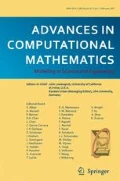Abstract
Model-order reduction methods tackle the following general approximation problem: find an “easily-computable” but accurate approximation \(\hat {\boldsymbol {h}}\) of some target solution h⋆. In order to achieve this goal, standard methodologies combine two main ingredients: (i) a set of partial observations of h⋆ and (ii) some “simple” prior model on the set of target solutions. The most common prior models encountered in the literature assume that the target solution h⋆ is “close” to some low-dimensional subspace. Recently, triggered by the work by Binev et al. (SIAM/ASA Journal on Uncertainty Quantification 5(1), 1–29, 2017), several contributions have shown that refined prior models (based on a set of embedded approximation subspaces) may lead to enhanced approximation performance. In this paper, we focus on a particular decoder exploiting such a “multi-space” information and evaluating \(\hat {\boldsymbol {h}}\) as the solution of a constrained optimization problem. To date, no theoretical results have been derived to support the good empirical performance of this decoder. The goal of the present paper is to fill this gap. More specifically, we provide a mathematical characterization of the approximation performance achievable by this variational “multi-space” decoder and emphasize that, in some specific setups, it has provably better recovery guarantees than its standard “single-space” counterpart. We also discuss the similarities and differences between this decoder and the one proposed in Binev et al. (SIAM/ASA Journal on Uncertainty Quantification 5(1), 1–29, 2017).
Similar content being viewed by others
Notes
We remind the reader that we assume m = n.
References
Argaud, J., Bouriquet, B., Gong, H., Maday, Y., Mula, O.: Stabilization of (G)EIM in presence of measurement noise: application to nuclear reactor physics. In: Spectral and High Order Methods for Partial Differential Equations ICOSAHOM 2016, pp 133–145. Springer (2017)
Babuska, I.: Error-bounds for finite element method. Numerische Mathematik 16, 322–333 (1970/71)
Binev, P., Cohen, A., Dahmen, W., DeVore, R., Petrova, G., Wojtaszczyk, P.: Data assimilation in reduced modeling. SIAM/ASA Journal on Uncertainty Quantification 5(1), 1–29 (2017). https://doi.org/10.1137/15M1025384
Chaturantabut, S., Sorensen, D.: Nonlinear model reduction via discrete empirical interpolation. SIAM J. Sci. Comput. 32(5), 2737–2764 (2010). https://doi.org/10.1137/090766498
Everson, R., Sirovich, L.: Karhunen-Loève procedure for gappy data. J. Opt. Soc. Am. A 12(8), 1657–1664 (1995). https://doi.org/10.1364/josaa.12.001657
Fick, L., Maday, Y., Patera, A. T., Taddei, T.: A reduced basis technique for long-time unsteady turbulent flows. ArXiv e-prints (2017)
Herzet, C., Diallo, M., Héas, P.: Beyond petrov-galerkin projection by using multi-space prior. In: European Conference on Numerical Mathematics and Advanced Applications (Enumath’17). (https://hal.inria.fr/hal-02173637v1), Voss, Norway (2017)
Herzet, C., Diallo, M., Héas, P.: Beyond Petrov-Galerkin projection by using multi-space prior. In: Model Reduction of Parametrized Systems IV (MoRePaS’18). (https://hal.inria.fr/hal-01937876), Nantes, France (2018)
Maday, Y., Mula, O., Patera, A.T., Yano, M.: The generalized empirical interpolation method: Stability theory on hilbert spaces with an application to the stokes equation. Computer Methods in Applied Mechanics and Engineering 287, 310–334 (2015). https://doi.org/10.1016/j.cma.2015.01.018. http://www.sciencedirect.com/science/article/pii/S0045782515000389
Maday, Y., Mula, O., Turinici, G.: Convergence analysis of the generalized empirical interpolation method. SIAM J. Numer. Anal. 54(3), 1713–1731 (2016)
Quarteroni, A., Manzoni, A., Negri, F.: Reduced Basis Methods for Partial Differential Equations, vol. 92. Springer International Publishing, Berlin (2016). http://www.springer.com/us/book/9783319154305
Funding
The authors thank the “Agence nationale de la recherche” for its financial support through the Geronimo project (ANR-13-JS03-0002).
Author information
Authors and Affiliations
Corresponding author
Additional information
Communicated by: Anthony Nouy
Publisher’s note
Springer Nature remains neutral with regard to jurisdictional claims in published maps and institutional affiliations.
This article belongs to the Topical Collection: Model Reduction of Parametrized Systems
Guest Editors: Anthony Nouy, Peter Benner, Mario Ohlberger, Gianluigi Rozza, Karsten Urban and Karen Willcox
Appendix: Proof of (42)
Appendix: Proof of (42)
In this appendix, we show that the cost function \(f({{\boldsymbol {h}}})\triangleq {\sum }_{j=1}^{{n}} {\left ({y}_{j}- \left \langle {{\boldsymbol w}_{j},{{\boldsymbol {h}}}}\right \rangle \right )}^{2}\) can be rewritten as in (42) when h ∈ Vn and σn > 0.Footnote 1 First, using the definition of yj, we have
Moreover, using the particular bases introduced in Section 5.1.1, we obtain
where the first equality follows from the fact that \(\{{{\boldsymbol {w}}}_{j}\}_{j=1}^{{n}}\) and \(\{{{\boldsymbol {w}}}_{j}^{*}\}_{j=1}^{{n}}\) differ up to an orthogonal transformation; the second is a consequence of (55) and our hypothesis h ∈ Vn.
Since \({{\hat {\boldsymbol {h}}}_{\text {SS}}}\) corresponds to the minimum of f(h) over Vn (see (17)), we simply have
if σn > 0. Hence, under this assumption, (2) can also be rewritten as in (42).
Rights and permissions
About this article
Cite this article
Herzet, C., Diallo, M. Performance guarantees for a variational “multi-space” decoder. Adv Comput Math 46, 10 (2020). https://doi.org/10.1007/s10444-020-09746-6
Received:
Accepted:
Published:
DOI: https://doi.org/10.1007/s10444-020-09746-6




